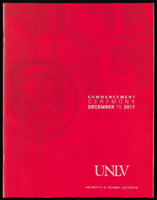Search the Special Collections and Archives Portal
Search Results
University of Nevada, Las Vegas Faculty Senate Records
Identifier
Abstract
The University of Nevada, Las Vegas (UNLV) Faculty Senate Records (1957-2001) primarily contain meeting agendas, minutes, correspondence, notices, and additional documents pertaining to the Nevada Southern University Faculty Senate and the UNLV Faculty Senate, as well as associated committees such as the Curriculum Committee, Graduate Program Evaluation Committee, and Status of Women Committee. The collection also includes constitutions, bylaws, handbooks, merit allocation lists, and reports.
Archival Collection
Nevada Consolidated Copper Company Photograph Albums
Identifier
Abstract
The Nevada Consolidated Copper Company Photograph Albums (1906-1907) contain two photograph albums from the mining company's chief engineer's office. The photograph albums include cyanotype and black-and-white photographs depicting the construction of the smelting plant, equipment, railroad, and landscape of Ruth, Nevada.
Archival Collection
Morton "Mort" Saiger Portraits and News Articles
Identifier
Abstract
The Morton "Mort" Saiger Portraits and News Articles (1960-1987) consists of four newspaper and journal articles about Saiger and the Last Frontier Hotel Casino, two professional photographic portraits of Saiger, and a presentation plaque from the International Golf Club.
Archival Collection
Southern Nevada Historical Society Records
Identifier
Abstract
The Southern Nevada Historical Society Records document the management and development of the Southern Nevada Historical Society (SNHS) as well as various historical projects in Las Vegas and Southern Nevada that the society sponsored from 1948 to 1983. The records include SNHS correspondence (1951-1978), meeting minutes (1958-1983), and accounting information (1959-1980). It also contains copies of the SNHS Backtrails Newsletter, promotional material for events, membership lists, and research materials for various projects related to the history of southern Nevada and Las Vegas.
Archival Collection
Stanley Mallin Papers
Identifier
Abstract
Collection consists of the 1974 lease agreement between Circus Circus and William Bennet and William Pennington, and a 1981 Desert Inn Country Club 25th Anniversary scrapbook.
Archival Collection
Las Vegas Art League Photograph Collection
Identifier
Abstract
The Las Vegas Art League Photograph Collection contains two photographic prints from between approximately 1960 and 1969. These photographs depict the director of the Las Vegas Art League, Lucile Spire Bruner, along with other individuals viewing and displaying art in Las Vegas, Nevada. Other individuals pictured are Bill Cramer, Miram Kapfer, Irene Chenin, Marge Herzoz, Mary Callahan, and Eleanor Badik.
Archival Collection
Barbara and John Kizziar Photograph Collection
Identifier
Abstract
The Barbara and John Kizziar Photograph Collection primarily contains black-and-white photographic prints and negatives of Hoover Dam (Boulder Dam) construction during John Kizziar’s time working for Six Companies Inc. between approximately 1986 and 1992. These images are reproductions of originals taken from between approximately 1930 and 1945. They detail John Kizziar’s work life during the dam’s construction, as well as events and scenes associated with the dam. Other images portray billboards and streets in Boulder City, Nevada. The collection also depicts other locations in Nevada, including Las Vegas, Mount Charleston, Black Canyon, the northern Mojave Desert, and the Colorado River ferry crossing between Nevada and Arizona.
Archival Collection

University of Nevada, Las Vegas (UNLV) Fall 2017 commencement program
Date
Archival Collection
Description
Commencement program from University of Nevada, Las Vegas Commencement Programs and Graduation Lists (UA-00115).
Text

Emilia Marquez oral history interview: transcript
Date
Archival Collection
Description
Oral history interview with Emilia Marquez conducted by Maribel Estrada Calderón on July 5, 2019 for the Latinx Voices of Southern Nevada Oral History Project. Claytee D. White and Emily Lucile are also present during the interview. Emilia Marquez was born in the United Stated and raised in Alexandria, Virginia, where her father worked as a bricklayer, until the age of twelve, when her father decided to move the family back to Uruguay. She describes acclimating to her new life in middle school and her shift from being perceived as an outsider in Uruguay to accepting Uruguay as home. She describes life in Uruguay and the positions that her family held while living there. After meeting and marrying her husband they trained to work in a casino. She trained as a slot machine operator, and her husband trained as a dealer. This eventually led them to leave Uruguay for the U.S. After the encouragement of her father and mother, she moved with her mother to Las Vegas to work in the casino industry. She describes working as a change person at the Luxor before moving to the newly opened Palms, where she worked until she left it to work at the Wynn. She ends the interview talking about various Uruguayan dishes and traditions, and a brief history of Uruguay. Subjects discussed in this interview: Uruguay, immigration, Las Vegas Strip, Latinx, Luxor.
Text

Transcript of interview with Hal G. Curtis by Bill Teepe, February 24, 1977
Date
Archival Collection
Description
On February 24, 1977, Bill Teepe interviewed Hal G. Curtis (born 1926 in Galt City, California) about his life in Southern Nevada. Curtis talks first about his work on the Union Pacific Railroad before discussing changes and development in Las Vegas, including development on the Strip and Downtown areas. He also talks about Block 16, the El Rancho Vegas fire, social clubs, and religion.
Text
